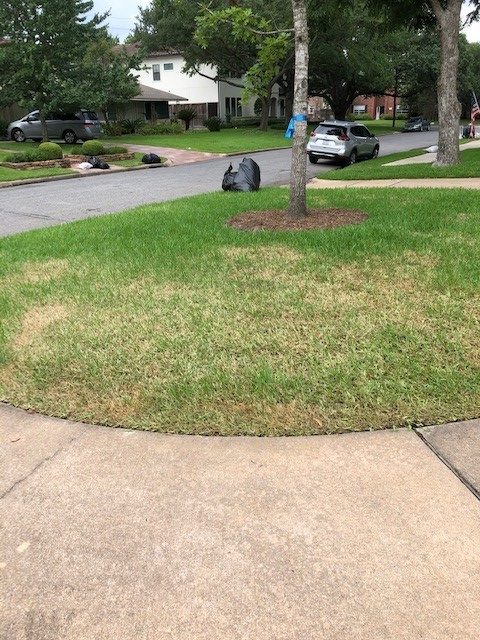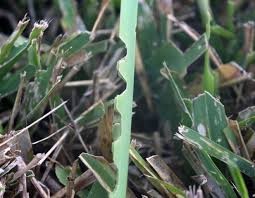Jump to Section:
Sod Webworm, Lawn Aeration
Sod Webworm
1. What is sod webworm?
Sod webworms are the caterpillar stage of lawn moths. There are many varieties of species, but the common one in the greater Houston area is from the genus Crambus. See the difference between the moth and the caterpillar stage below.


2. How does the sod webworm damage the grass?
The adult moth does not damage the grass directly. It lays the eggs, and they hatch to become caterpillar (sod webworm). The sod webworm caterpillar will eat (chew) various types of grass, especially St. Augustine Grass. We have also seen the damage on Bermuda grass, but to a lesser extent.
3. How does the damage look like? How do I know if I have the issue?
You would notice brown/gray spots on the lawn, especially in a circular pattern (see pictures below). The brown lawn areas are of lower grass height than the rest. The lower grass height area would show a chewed-up pattern at the blade tip and sides and/or left-over white fibers. When walking on the area, you may find a bunch of brown/white colored moth flies around. If you dig up the thatch level of the affected area, you might find a green color worm hiding below it. They only come out in the dark (nighttime).




4. Do I have to be concerned about it?
Yes – depending on the severity of the webworm activity, it may damage the lawn quickly, and the grass would lose its ability to grow due to the absence of enough chlorophyll to photosynthesize. Even though the roots are not damaged by sod webworm, in many cases, it might not recover due to the reason above.
5. Why is this happening to my lawn?
This is none of your doing. Sod webworm infestation happens typically when the right weather condition and pattern present, and it is ordinarily aerial infestation (not specific lawns). The last massive outbreak in Houston occurred in the summer/fall of 2017. Currently (summer of 2020) is the next significant infestation that we have experienced.
6. How do I protect my grass?
Our recommendation for such a large aerial infestation is to do a combination of a contact insecticide and preventive systemic insecticide treatment.
7. What is your treatment plan for sod webworm?
We offer Lawn Insect Preventive (LIP) service. The contact insecticide will kill the worms immediately and the systemic insecticide to get in the grass vascular system and remain there for up to 90-days. It will kill the sod webworm caterpillar (or many other insects) when the pest tries to feed on the grass either by chewing or sucking.
8. Is the Lawn Insect Preventive (LIP) treatment part of the Lawn Maintainer Program I have with Lawn Doctor already?
Our Lawn Maintainer Program (LMP) covers only fertilization and weed control. The LIP service is additional. Most of our Lawn Maintainer customers sign up on LIP add-on by default annually to protect the grass from various turfgrass insects such as armyworm, chinch bug, grubs, etc. The LIP program consists of two treatments – one in late spring/summer and another late summer/fall to provide all-season control and protect the turfgrass from almost all common turfgrass insects.
9. Why your treatment is more expensive than your competition?
We want to provide the right solutions for our customers and focus on long-term results. Our solutions are proven with our experience dealing with such a situation. We use premium, technologically advanced, EPA-registered, and safe systemic insecticide combined with a contact insecticide. It does not need repeat treatments (unless the infestation will remain more than 90-days). In addition, we provide a warranty that if the treatment did not protect your grass from sod webworm, we will come out and repeat the procedure without any charge. Our competition may use contact only insecticide and/or older-technology insecticide that might have developed resistance by the insects.
10. After your treatment, I still see way too much moths lingering around. Your treatment did not work?
This is a very common question we get. Remember that the treatment is targeted at the sod webworm caterpillar, not the moth. Immediately after the treatment, you will see a reduced moth population die to the contact insecticide. Still, after a few days, the moth population will be back because this is an aerial infestation. Besides, as mentioned before, the moths do not damage the grass directly.
11. It rained heavily not long after your treatment. Isn’t my treatment washed away and diluted?
As mentioned, we use a systemic insecticide. The main advantage of systemic insecticide is that it is not affected by rain, sun, or any other environmental conditions that would typically reduce the effectiveness of a contact-only insecticide. The products we use will be rain-fast when it has dried. In summer, our treatment will generally dry in less than 30-min. Rain afterward will not affect the treatment. In addition, when the insecticide is in the soil, it is taken up by the roots of the plant, providing a systemic action.
12. How do I know your treatment work?
The presence of moths is not an indicator if the treatment worked. The best indicator is to look at your grass and ensure the brown/gray spot is not worsening or becoming larger. The result is what counts. If you see the lawn is deteriorating even after we treated, please call us immediately and will come out and re-treat your lawn at no charge. Our call back rate is less than 2% for these treatments.
13. How can I maximize the treatment efficacy?
Avoid mowing your lawn the same day of the treatment. If you need to mow the same day after the treatment, mulch the grass clippings (do not collect the grass) and water the next day. Water as usual within 2-days of treatment so the excess insecticide will be absorbed thru the roots.
14. Why don’t you treat the moth – it drives me crazy.
As mention before, the moths do not damage your grass directly. But for sure, they are a nuisance. We do not prefer to treat the moth because the effectiveness does not last long, and we do not want you to waste your money as we rely on contact pyrethroid that contacts them directly to kill. Unlike mosquitoes, the moths are much larger in size. However, if you like to reduce their presence regardless (maybe weekend outdoor event), we can provide misting services (like we do for mosquitoes). But understand the moths will be back eventually from the area.
15. There are so many moths in my flower beds and shrubs. Do I have to worry about it?
The sod webworm moths shelter and mate in the hidden areas of the shrubs. They are not known to damage any tree or shrubs.
Lawn Aeration
1. When will I know the date of the aeration after I sign-up?
We work on a route system to aeration for a particular area. We will give you a 2-3 days’ notice when your lawn aeration is scheduled.
2. Do I need to flag my lawn before aeration?
Absolutely! Flag hidden objects on your lawn such as sprinkler heads, invisible fences, valve box covers, in-ground lights. Lawn Doctor is not responsible for accidental damage to hard-to-see objects on the lawn that is left unmarked.
3. Where can I get the marking flags?
You can get the flags in any Home improvement store such as HomeDepot or Lowes.
4. Do I need to do anything else before the aeration?
We do recommend a few steps to maximize the aeration process for your lawn:
- Mow your lawn (make it lower than usual without scalping it) 1-2 days before the aeration day. Lower grass height will ensure your lawn gets deeper core holes.
- Do not water your lawn 1-2 days before aeration to minimize the risks of leaving any ruts or damaging the sod.
- Clean up any leaves, trash, or other debris that might interfere with the aerator.
5. Do I need to do anything after the lawn aeration?
We recommend you water your lawn thoroughly the following day or within 48-hours for maximum benefits. This will also help break down the cores, which will disappear within 1-3 weeks.
6. Can all areas of my lawn be aerated?
Unfortunately no. We will be able to aerate where the machine can access the area safely and without risking any damage around it. Tight places are difficult to aerate and could be more damaging than beneficial.
7. What kind of aerator machine does Lawn Doctor use?
We use the least generation stand-on core aerator machine. We also carry a smaller 24” walk-behind aerator to cover smaller and tight areas. Our machine needs at least an access (gate) width of 36”. We will not be able to perform aeration for any smaller access.
8. Can aeration damage my underground lawn sprinkler, water, gas or cables?
By various standards, these different pipes or cables must be buried by at least 8 in minimum. Our machine cannot plug holes more than 5 in max, assuming bare ground. With grass, the depth will vary between 2-4 inches.
9. Will you compensate for any damages from the lawn aeration?
Lawn Doctor is not responsible for accidental damage to hard-to-see objects on the lawn that is left unmarked. Also, we have experienced some underground cable or pipes installation made not up to the required standard depth and caused accidental damage during aeration. We are not responsible for these damages that are beyond our control.
